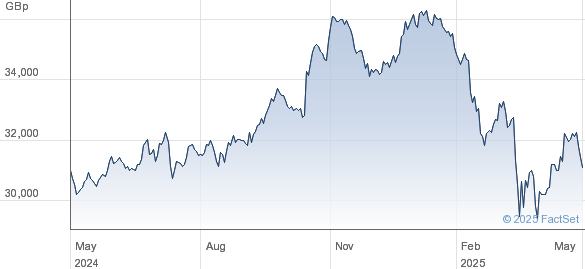The Amundi Dow Jones Industrial Average UCITS ETF: What Is Net Asset Value?

Table of Contents
What is Net Asset Value (NAV) and How is it Calculated?
Net Asset Value (NAV) represents the per-share value of an ETF's underlying assets. Simply put, it's the total value of everything the ETF owns (its assets) minus what it owes (its liabilities), divided by the number of outstanding shares. This provides a snapshot of the ETF's intrinsic worth.
- Components of NAV Calculation:
- Assets: This includes the market value of all the securities held by the ETF, such as stocks making up the Dow Jones Industrial Average in this case.
- Liabilities: These are the ETF's expenses, including management fees and other operational costs.
Understanding NAV calculation is key to valuing ETFs accurately. The formula is straightforward: (Total Asset Value - Total Liabilities) / Number of Outstanding Shares = NAV.
How the Amundi Dow Jones Industrial Average UCITS ETF NAV is Determined
The NAV of the Amundi Dow Jones Industrial Average UCITS ETF is determined daily, reflecting the closing prices of the 30 constituent companies of the Dow Jones Industrial Average. The ETF aims to track the index's performance, so the NAV closely mirrors the index's value.
- Calculation Process: The fund manager calculates the NAV by summing the market value of each holding, deducting liabilities, and dividing by the number of outstanding shares. This calculation usually happens at the end of each trading day.
- Factors Affecting Calculation: Fluctuations in the Dow Jones Industrial Average directly impact the NAV. Changes in the exchange rates (if the ETF holds international assets) and accrued income also influence the NAV.
NAV vs. Market Price
While NAV represents the intrinsic value, the market price reflects the price at which the ETF is bought and sold on the exchange. These values may differ due to market forces like supply and demand.
- Factors Influencing Market Price: Higher demand can push the market price above the NAV (a premium), while lower demand can lead to a price below the NAV (a discount). Trading volume and investor sentiment also play a role.
The Importance of Monitoring NAV for Amundi Dow Jones Industrial Average UCITS ETF Investors
Monitoring the NAV of your Amundi Dow Jones Industrial Average UCITS ETF investment provides several crucial benefits.
Tracking Performance
Regularly checking the NAV allows you to track your investment's performance over time. By comparing the NAV on different dates, you can see the growth or decline of your investment.
- Accessing NAV Data: Daily NAV data is readily available on the Amundi website, financial news websites, and through your brokerage account.
Making Informed Investment Decisions
Understanding NAV helps you make informed buy and sell decisions. While not the sole factor, consistent undervaluation (a significant discount) might indicate a potential buying opportunity, while consistent overvaluation (a significant premium) might suggest considering a sale.
- NAV and Investment Returns: Consistent growth in the NAV indicates positive investment returns, while a decline signals losses.
Risk Management
NAV fluctuations reflect the inherent risk associated with the ETF. Monitoring NAV changes helps assess the impact of market volatility on your investment. Large and sudden drops in NAV may indicate higher risk.
- Market Fluctuations and NAV: Market downturns can lead to significant drops in the NAV, highlighting the need for a well-diversified portfolio and a long-term investment strategy.
Conclusion: Understanding Net Asset Value in your Amundi Dow Jones Industrial Average UCITS ETF Investment
Understanding Net Asset Value (NAV) is vital for anyone invested in the Amundi Dow Jones Industrial Average UCITS ETF or any ETF. Monitoring the NAV allows you to track performance, make informed investment decisions, and manage risk effectively. Regularly reviewing your ETF's NAV provides a clear picture of your investment's health and allows for proactive adjustments to your investment strategy. To further enhance your understanding of NAV and its implications for your Amundi Dow Jones Industrial Average UCITS ETF investments, consider exploring resources available on the Amundi website or consulting with a qualified financial advisor. Remember, informed decisions lead to better investment outcomes.

Featured Posts
-
 5 Zodiac Signs With Favorable Horoscopes On April 14 2025
May 24, 2025
5 Zodiac Signs With Favorable Horoscopes On April 14 2025
May 24, 2025 -
 Find Housing Finances Sorted And Fun For The Family At The Iam Expat Fair
May 24, 2025
Find Housing Finances Sorted And Fun For The Family At The Iam Expat Fair
May 24, 2025 -
 A Look At Nicki Chapmans Private Garden In Chiswick
May 24, 2025
A Look At Nicki Chapmans Private Garden In Chiswick
May 24, 2025 -
 Is The Glastonbury 2025 Lineup A Letdown For Fans
May 24, 2025
Is The Glastonbury 2025 Lineup A Letdown For Fans
May 24, 2025 -
 Apple Price Target Cut Is Wedbush Right To Remain Bullish
May 24, 2025
Apple Price Target Cut Is Wedbush Right To Remain Bullish
May 24, 2025
